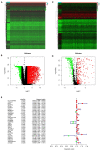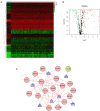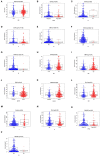Identification of an Individualized Immune-Related Prognostic Risk Score in Lung Squamous Cell Cancer
- PMID: 33747902
- PMCID: PMC7966508
- DOI: 10.3389/fonc.2021.546455
Identification of an Individualized Immune-Related Prognostic Risk Score in Lung Squamous Cell Cancer
Abstract
Background: Lung squamous cell carcinoma (LUSC) is one of the most common histological subtypes of non-small cell lung cancer (NSCLC), and its morbidity and mortality are steadily increasing. The purpose of this study was to study the relationship between the immune-related gene (IRGs) profile and the outcome of LUSC in patients by analyzing datasets from The Cancer Genome Atlas (TCGA). Methods: We obtained publicly available LUSC RNA expression data and clinical survival data from The Cancer Genome Atlas (TCGA), and filtered IRGs based on The ImmPort database. Then, we identified risk immune-related genes (r-IRGs) for model construction using Cox regression analysis and defined the risk score in this model as the immune gene risk index (IRI). Multivariate analysis was used to verify the independent prognostic value of IRI and its association with other clinicopathological features. Pearson correlation analysis was used to explore the molecular mechanism affecting the expression of IRGs and the correlation between IRI and immune cell infiltration. Results: We screened 15 r-IRGs for constructing the risk model. The median value of IRI stratified the patients and there were significant survival differences between the two groups (p = 4.271E-06). IRI was confirmed to be an independent prognostic factor (p < 0.001) and had a close correlation with the patients' age (p < 0.05). Interestingly, the infiltration of neutrophils or dendritic cells was strongly upregulated in the high-IRI groups (p < 0.05). Furthermore, by investigating differential transcription factors (TFs) and functional enrichment analysis, we explored potential mechanisms that may affect IRGs expression in tumor cells. Conclusion: In short, this study used 15 IRGs to build an effective risk prediction model, and demonstrated the significance of IRGs-based personalized immune scores in LUSC prognosis.
Keywords: TCGA; immune-related genes; lung squamous cell carcinoma (LUSC); prognosis; transcriptome.
Copyright © 2021 Zhuang, Li, Liu and Li.
Conflict of interest statement
The authors declare that the research was conducted in the absence of any commercial or financial relationships that could be construed as a potential conflict of interest.
Figures







Similar articles
-
Identification of a Prognostic Model Based on Immune-Related Genes of Lung Squamous Cell Carcinoma.Front Oncol. 2020 Sep 2;10:1588. doi: 10.3389/fonc.2020.01588. eCollection 2020. Front Oncol. 2020. PMID: 33014809 Free PMC article.
-
A robust signature associated with patient prognosis and tumor immune microenvironment based on immune-related genes in lung squamous cell carcinoma.Int Immunopharmacol. 2020 Nov;88:106856. doi: 10.1016/j.intimp.2020.106856. Epub 2020 Aug 7. Int Immunopharmacol. 2020. PMID: 32777677
-
Development and validation of a novel immune-related prognostic model in lung squamous cell carcinoma.Int J Med Sci. 2020 Jun 1;17(10):1393-1405. doi: 10.7150/ijms.47301. eCollection 2020. Int J Med Sci. 2020. PMID: 32624696 Free PMC article.
-
Establishment of the prognostic index of lung squamous cell carcinoma based on immunogenomic landscape analysis.Cancer Cell Int. 2020 Jul 20;20:330. doi: 10.1186/s12935-020-01429-y. eCollection 2020. Cancer Cell Int. 2020. PMID: 32699529 Free PMC article.
-
Identification of an Innate Immune-Related Prognostic Signature in Early-Stage Lung Squamous Cell Carcinoma.Int J Gen Med. 2021 Nov 30;14:9007-9022. doi: 10.2147/IJGM.S341175. eCollection 2021. Int J Gen Med. 2021. PMID: 34876838 Free PMC article.
Cited by
-
A novel DNA damage repair-related signature for predicting prognositc and treatment response in non-small lung cancer.Front Oncol. 2022 Nov 4;12:961274. doi: 10.3389/fonc.2022.961274. eCollection 2022. Front Oncol. 2022. PMID: 36408135 Free PMC article.
-
Identification, Verification and Pathway Enrichment Analysis of Prognosis-Related Immune Genes in Patients With Hepatocellular Carcinoma.Front Oncol. 2021 Sep 20;11:695001. doi: 10.3389/fonc.2021.695001. eCollection 2021. Front Oncol. 2021. PMID: 34616672 Free PMC article.
-
Prediction of Tumor Microenvironment Characteristics and Treatment Response in Lung Squamous Cell Carcinoma by Pseudogene OR7E47P-related Immune Genes.Curr Med Sci. 2023 Dec;43(6):1133-1150. doi: 10.1007/s11596-023-2798-2. Epub 2023 Nov 28. Curr Med Sci. 2023. PMID: 38015361
-
Development and Validation of an Immune-Based Prognostic Risk Score for Patients With Resected Non-Small Cell Lung Cancer.Front Immunol. 2022 Mar 23;13:835630. doi: 10.3389/fimmu.2022.835630. eCollection 2022. Front Immunol. 2022. PMID: 35401554 Free PMC article.
-
ALDH2 polymorphism rs671 is a predictor of PD-1/PD-L1 inhibitor efficacy against thoracic malignancies.BMC Cancer. 2021 May 22;21(1):584. doi: 10.1186/s12885-021-08329-y. BMC Cancer. 2021. PMID: 34022841 Free PMC article.
References
LinkOut - more resources
Full Text Sources
Other Literature Sources

